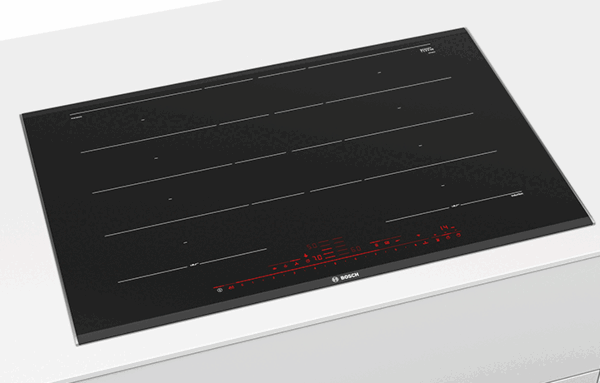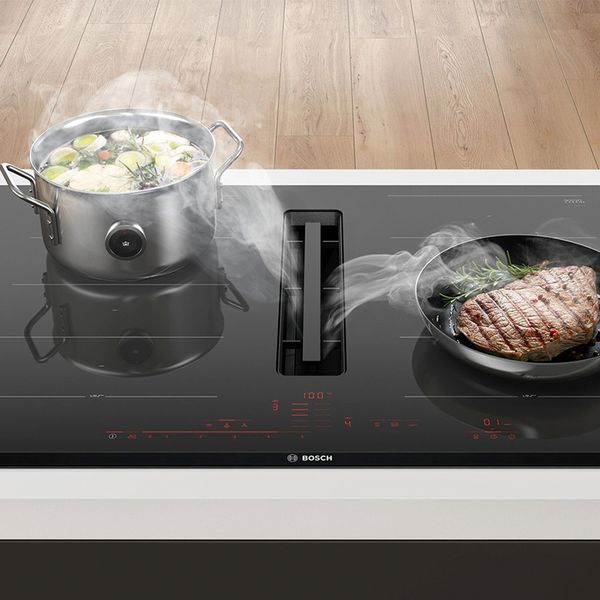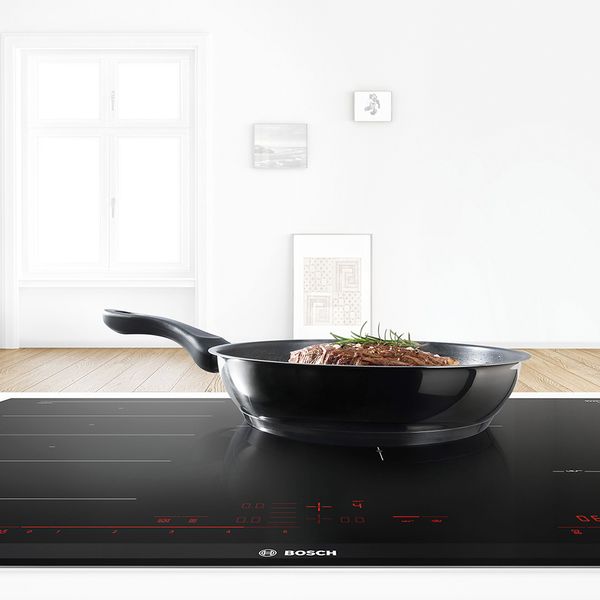Ready to choose a new induction or ceramic hob? Our Hob Finder makes it easy. After answering a few questions about your kitchen space and personal tastes, we'll tell you which model ticks all the boxes.
Coming soon.
What is an induction hob? What is a ceramic hob? What is the difference between an induction hob and a ceramic hob?
Which induction hob sizes are available? What about a venting hob? You might be asking yourself these great questions if you're looking for a new electric hob. Our buying guide for induction hobs and ceramic hobs is here to help.
The first choice to make is between induction and radiant heat. You might also want to look at venting hobs, which have an integrated hood fan. Factors like hob sizes and hob controls are also important. Perhaps you also want to look at a hob's energy-efficiency or are interested in the latest advances in technology.
Below we explain what to consider when choosing a new electric hob for your kitchen.
With a flat black cooking surface, induction hobs and ceramic hobs (radiant hobs) are visually very similar. The main difference lies in their performance: induction heats much more quickly and efficiently. An induction model is also easier to clean. Since the surface of an induction hob doesn't get hot, there are no burnt food bits to scrape off. If your current hob is ceramic (radiant), you can install an induction hob in the same cutout.
Our induction hobs come in varying widths, ranging from 30 to 78cm. The right one for you depends on your cooking habits and the space available in your kitchen. A wider hob lets you comfortably cook with multiple pots or pans at once.
Ceramic and induction hob sizes.
Ceramic and induction models are available in the following widths:
Pro tip: If you have an extractor hood, your hob should be the same width or slightly narrower.
An induction hob is controlled either by knobs on the oven or a type of touch-based controls on the hob's surface. Depending on the model, the touch-based options range from basic touch buttons to an advanced touchscreen:

If you cook with large pots and pans, or rectangular cooking vessels such as roasting pans, you might want a hob with a flexible cooking zone.
Maximum flexibility: Merge two or more FlexInduction's rectangular induction zones to create a large one of varying dimensions.

A venting hob, also known as a downdraft hob, is essentially an electric hob and a hood fan in one appliance. Built in below the hob is a powerful extractor fan that, when in use, sucks away steam and odours from pots or pans on the cooking surface.
Pro tip: In a venting hob, the "hood" is cleverly hidden below the worktop. It's perfect for an island or for those who don't want a visible hood fan. However, it's slightly deeper than a non-venting hob.

Many of our hobs come with innovative and smart features that make sautéing, frying and boiling more enjoyable.
Avoid scorching: The PerfectFry sensor regulates the temperature during frying, adjusting it automatically if needed.
Ready to choose a new induction or ceramic hob? Our Hob Finder makes it easy. After answering a few questions about your kitchen space and personal tastes, we'll tell you which model ticks all the boxes.
Coming soon.

High-quality and reliable Bosch induction hobs are among the market leaders. Our German-engineered induction hobs are made according to high quality standards. So you can be certain to get a reliable appliance that will serve you well long term. Numerous awards from independent test institutes prove their excellence.
Generally speaking, induction hobs are more energy efficient than ceramic hobs. We prioritise offering people worldwide durable hobs that last long and consume less. The precise energy consumption of an induction hob can vary from model to model. To find a hob with especially low energy consumption, it's best to review a product's specifications.